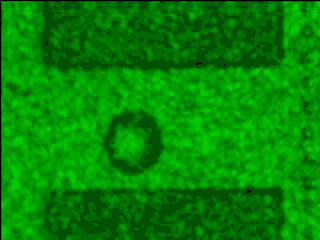Traces of nanobubbles determine nanoboiling
To observe the process, the NIST/Cornell team used a unique ultrafast laser strobe microscopy technique with an effective shutter speed of eight nanoseconds to photograph bubbles growing on a microheater surface about 15 micrometers wide. At this scale, a voltage pulse of only five microseconds superheats the water to nearly 300 °C, creating a microbubble tens of microns in diameter. When the pulse ends, the microbubble collapses as the water cools. What the team found was that if a second voltage pulse follows closely enough, the second microbubble forms earlier during the pulse and at a lower temperature apparently, as conjectured by the team, because nanobubbles formed by the collapse of the first bubble become new nucleation sites for the growth of later bubbles. The nanobubbles themselves are too small to observe, but by changing the timing between voltage pulses and observing how long it takes the second microbubble to form, the researchers were able to estimate the lifetime of the nanobubbles—roughly 100 microseconds.
These experiments are believed to be the first evidence that nanoscale bubbles can form on hydrophilic surfaces (previous evidence of nanobubbles was found only for hydrophobic surfaces like oilcloth) and the method for measuring nanobubble lifetimes may improve models for optimal heat transfer design in nanostructures. The work has immediate implications for inkjet printing, in which a metal film is heated with a voltage pulse to create a bubble that is used to eject a droplet of ink through a nozzle. If inkjet printing is pushed to higher speeds (repetition rates above about 10 kilohertz), the work suggests, nanobubbles on the heater surface between pulses will make it difficult or impossible to control bubble formation properly.
The findings also may impact proposed thermal cancer therapies in which nanoscale objects are designed to accumulate in tumors and are subsequently heated remotely by infrared radiation or alternating magnetic fields. Each particle acts as a nanoscale heater, with nanobubbles being created if the applied radiation is sufficient. The bubbles may have a therapeutic effect through additional heat delivered and mechanical stresses they may impart to the surrounding tissue. ###
 | First Nucleation: This clip shows bubble nucleation during the first pulse of a two-pulse sequence. The first frame is at a delay of 3.5 microseconds from the start of the voltage pulse. Succeeding frames are 10 ns apart. This clip in dv format. or This clip in avi format. |
 | Growth and Collapse: during the first pulse of a two-pulse sequence. The first frame is at a delay of 3.5 microseconds from the start of the voltage pulse. Succeeding frames are 50 ns apart. This clip in dv format. or This clip in avi format. |
 | Second Nucleation: This clip shows bubble nucleation during the second pulse of a two-pulse sequence. The first frame is at a delay of 1.8 microseconds from the start of the voltage pulse. This clip in dv format. or This clip in avi format. |
 | Growth and Collapse: during the second pulse of a two-pulse sequence. The first frame is at a delay of 1.8 microseconds from the start of the voltage pulse. Succeeding frames are 50 ns apart. This clip in dv format. or This clip in avi format. |
Technorati Tags: nanofibers or Nanoscientists and Nano or Nanotechnology and nanoparticles or Nanotech and nanotubes or nanochemistry and nanoscale or nanowires and Nanocantilevers or nanometrology and nanoseconds or National Institute of Standards and Technology and bubble nucleation or Cornell University















No comments:
Post a Comment